Essays >> Real and Counterfeit Cup Fungi
Real and Counterfeit Cup Fungi
Sometimes when you are walking through a coniferous forest you may look up, instead of down where the mushrooms are. If there are fir trees where you are walking you may notice some small pink, orange or yellow fungi on dead branches and trunks. These little cup-and-saucer-fungi may look almost alike but are really two quite unrelated species, Lachellula agassizii and Aleurodiscus amorphus. If they are growing on an upright trunk they may be close together and distinguishable mainly by their colour, yellow to orange-yellow in L. agassizii and yellow-orange to pink in A. amorphus. If they are growing on a more horizontal branch you may find the Lachnellula on top and the Aleurodiscus below. Check this for yourself; winter and spring are best, especially if it has been raining and the branches are wet.
The two species may appear to be similar, but each has its own "personality". If we look below the surface we find a richness of structure, ecology and human history. Typical fungi!
Lachnellula agassizii
In going below the surface it makes sense to begin in a copper mine. The mine belonged to a man named Alexander Agassiz, pictured below at left, son of the renowned Swiss geologist Jean Louis Rodolph Agassiz. The senior Agassiz became famous for showing that glaciers had once covered much of Europe, producing what we now call an "Ice Age". He later moved with his wife and son Alexander to Massachusetts where he accepted a position at Harvard University. Although mainly a geologist he had a profound knowledge of biology, especially botany.
Alexander Agassiz was an enterprising young man who became an authority on marine fish but who was also quite interested in mining. He invested in the development of a copper mine in Calumet on the Keweenaw Peninsula of northern Michigan. Initially he was an assistant in the Harvard Museum of Natural History but in 1866 travelled to Calumet to see the mine for himself. The fortunes of the mining company were in decline at that time and the following year he moved there with his wife and son to get things back on track.
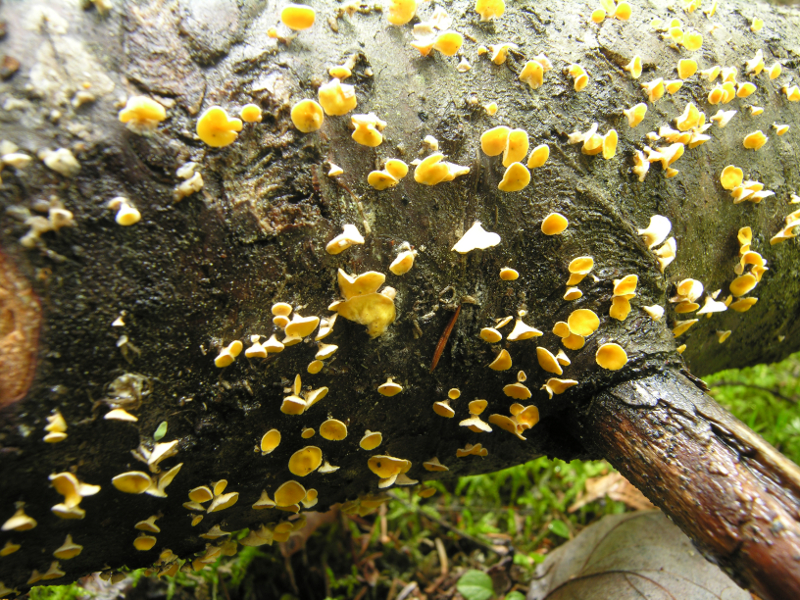
As the mine became more profitable Agassiz was able to return to Harvard and to his work in natural history. He continued to visit the mine in the spring and fall, but otherwise began world-wide scientific investigations, resulting in his recognition as a leading marine biologist. These twice-a-year travels to Calumet led to another discovery directly relating to our own walks in the woods.
On one of Agassiz' visits to Calumet he noticed a small yellow cup fungus growing on a dead fir tree. He was unable to identify it and sent it off to the Rev. Moses Ashley Curtis (centre picture) in North Carolina, an authority on American fungi, to see if he knew what it was. Curtis was stumped and forwarded the specimen to the Rev. Miles Joseph Berkeley, in the righthand picture, the leading British authority on fungi. In 1875 Berkeley and Curtis published Agassiz' find as a new species and called it Peziza agassizii. In later years mycologists decided it did not really belong in the genus Peziza, and in 1962, the eminent British expert on cup fungi, R.W.G. Dennis, renamed it Lachnellula agassizii.
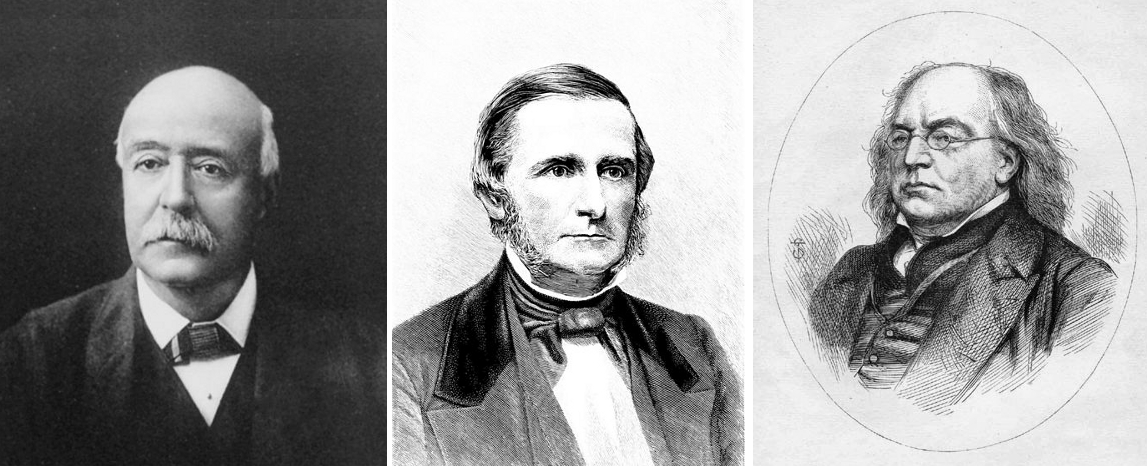
Lachnellula agassizii is an ascomycete now assigned to the family Hyaloscyphaceae of the order Helotiales. In non-specialist language this tells us that L. agassizii is an inoperculate cup fungus having apothecia with external hairs. That still sounds like jargon, doesn't it? So let's break that down further, not only just to understand the language, but also to fully appreciate the charms of this common and beautiful fungus.
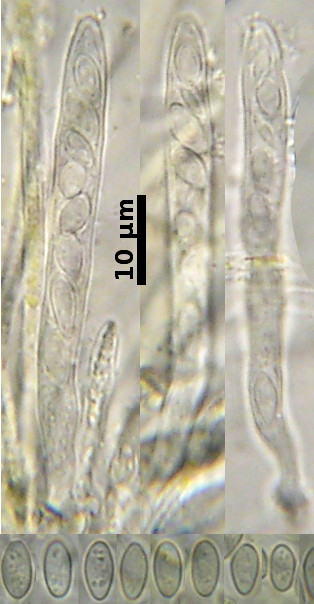
As you probably already know, ascomycetes are fungi that produce their spores in an ascus (plural: asci). Asci come in a variety of sizes and shapes, ranging from round to tubular. Most asci are tubular and contain eight spores, called ascospores. The most common function of asci is to shoot their ascospores off into the air, often to a surprisingly great distance. Asci are constructed like little pop-guns powered by water pressure. When the spores are ready to be dispersed the asci begin to take in water until the pressure nearly bursts their walls. The final release of pressure takes place through a little opening at the top of the ascus. In one group of fungi called the operculate cup fungi, the opening in the ascus occurs by the opening of a little toilet-seat-like lid called an operculum. The pressure in the ascus forces each of the eight spores, one at a time, into the opening where it momentarily lodges. Then as pressure behind it builds up it is fired off and its place in the opening is taken by the next ascospore in line. Of course all eight are fired away in a fraction of a second. In large operculate discomycetes like species of Helvella, you can actually hear this discharge, which sounds like the fizzing of a freshly poured glass of pop. The inoperculate cup fungi have asci that work in a similar way except the opening is a more elaborate pore without a lid.
So what is a cup fungus? As the name implies, the fruiting bodies of many are shaped like little cups or goblets. The technical term for one of these little cups is an apothecium (plural: apothecia). In reality not all apothecia are shaped like cups and may be more like saucers or even stalked saddles. Morels are made up of many cups and resemble sponges, while false morels look more like brains. Mycologists are interested in the details of apothecia, such as colour and presence of distinctive hairs. The apothecia of L. agassizii are yellow to orange on the inside and white on the outside due to the presence of fine hairs.
Mycologists know little about the natural history of L. agassizii, although it is very common and can be found throughout the range of balsam fir in North America. It does not grow on living firs as far as we know, although the possibility exists that it is growing under the bark of living trees but not producing apothecia. We do know that the related species L. willkommii causes a serious disease of larches, so the question of its parasitism is still open. When a tree or part of a tree dies it will be found in abundance the following year. It seems to make its appearance in the fall and be present through the winter and into the following spring and early summer. It is fully mature during that first winter and will freely shoot away its ascospores if brought into a warm room and kept moist. In our mild Atlantic climate it is probably able to discharge some of its ascospores during winter thaws. In central Canada it probably shuts down until spring.
Aleurodiscus amorphus
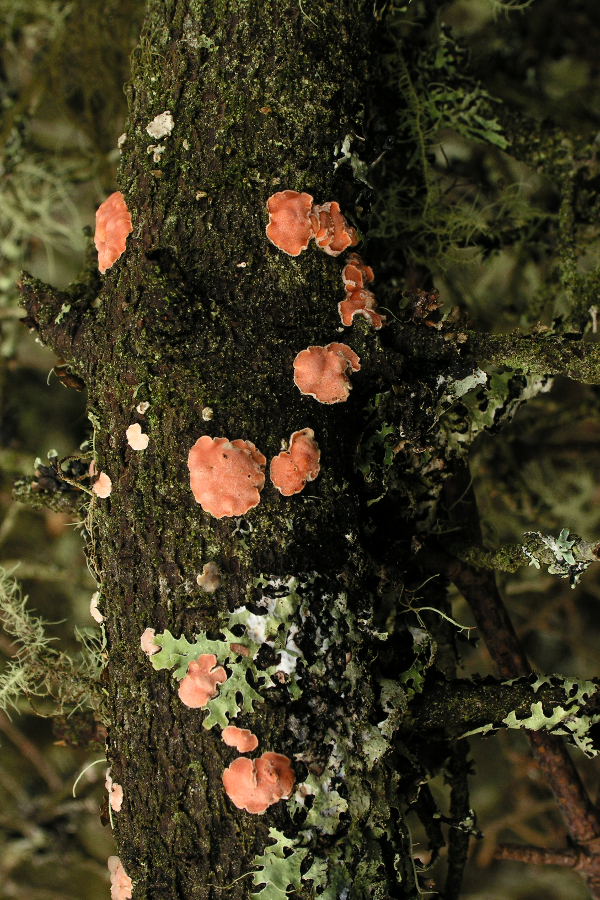
You may remember the name Peziza, used by the Revs. Berkeley and Curtis to accommodate their new species P. agassizii. We now restrict the genus Peziza to operculate discomyces with large apothecia, but in the early days of mycology it was applied to all cup fungi. This was the equivalent to calling all mushrooms Agaricus. But if Peziza was an inappropriate name for Berkeley and Curtis's new species it was wildly off base of what we call A. amorphus. Yet 1801 Christiaan Hendrik Persoon did just that, naming it Peziza amorpha. Persoon, in the lefthand picture, was a poverty-stricken, reclusive, South African-born mycologist who spent most of his adult life in Paris studying fungi and writing about them, finally receiving a small pension by selling his collections to the Dutch. Amazingly, Persoon's collections are still preserved at the large herbarium in Leiden, The Netherlands. They are today among the most valued of all mycological collections. Persoon probably did not own or use a microscope and it was more than 35 years later before mycologists realized that this little saucer-shaped "Peziza" was actually a basidiomycete.

In 1838 the Swedish mycologist Elias Magnus Fries (righthand picture), realizing the real nature of this species put it into the basidiomycete genus Corticium as C. amorphum. The genus Corticium was also a catch-all genus at that time, used for all flat (resupinate) basidiomycetes and in 1888 Joseph Schröter, a German mycologist, gave it the name A. amorphus we use today. This modern name is of Greek derivation: aleuro- means "mealy" and discus- means "disk", referring to the mealy surface of the little disk-shaped fruiting bodies. Ironically, the species name, amorphus, means "without form". Are they disk-shaped or not? Modern classification systems place A. amorphus in the Russulaceae, a family most commonly known for the mushroom genera Russula and Lactarius, even though the fruiting bodies are corticioid and quite unlike mushrooms.
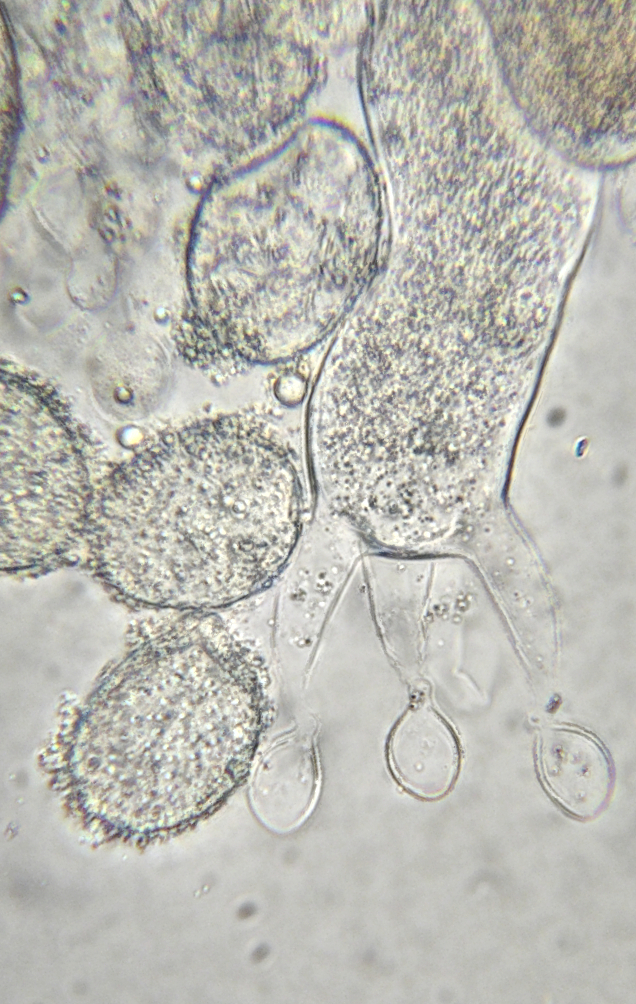
Like all other basidiomycetes, A. amorphus produces its basidiospores on basidia (singular: basidium). Basidia can be vary quite a bit from fungus to fungus but are usually elongated and club-shaped. The spores are formed at the ends of little horns called sterigmata, right at the ends of the basidia.
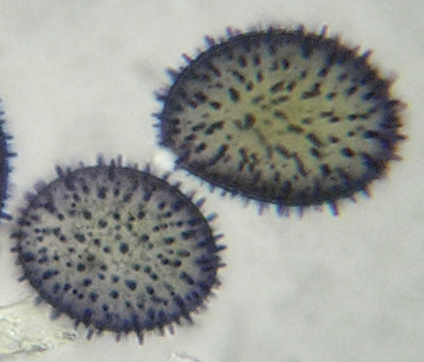 Basidiospores are usually borne a group of four at the end of each basidium, although basidia with two- or even eight basidiospores are produced by some fungi. Although the basidiospores are usually shot away from the sterigmata when they are mature this is not the cannon-like process used by the ascomycetes. Instead, the basidiospores are gently popped off where they can drift away to their destination. This gentle discharge explains why nearly all basidiomycetes, including the mushrooms and polypores, are oriented so their spores can fall away by gravity and then travel on the wind. This is why you will usually find A. amorphus on the bottom of a branch.
Basidiospores are usually borne a group of four at the end of each basidium, although basidia with two- or even eight basidiospores are produced by some fungi. Although the basidiospores are usually shot away from the sterigmata when they are mature this is not the cannon-like process used by the ascomycetes. Instead, the basidiospores are gently popped off where they can drift away to their destination. This gentle discharge explains why nearly all basidiomycetes, including the mushrooms and polypores, are oriented so their spores can fall away by gravity and then travel on the wind. This is why you will usually find A. amorphus on the bottom of a branch.
The basidiospores of A. amorphus are very spiny, almost like little hedgehogs. This is interesting enough, but these tiny spines also amaze us by turning blue-black in solutions of iodine, a phenomenon we call the amyloid reaction.
Ecology
Lachnellula agassizii and A. amorphus seem pretty similar in appearance and ecology. Both are found almost exclusively on fir and both grow on trunks and branches that have been dead for about a year. Both need to get their spores to a new tree if they are to ensure the survival of their offspring, and it seems reasonable to expect this to be done in similar ways. Lachnella agassizii lives on top of the branch and shoots its spores up into the wind while A. amorphus is on the bottom dropping its spores down into the air. In a typical eastern coniferous forest neither species should have a problem getting its spores to another fir.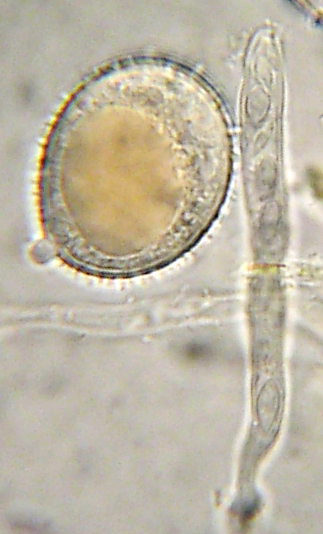
A comparison of the two species together under a microscope puts a little wrench in our ecological gears. The spiny basidiospores of A. amorphus are immense compared to the smooth ascospores of L. agassizii. One ascus with all its spores would fit comfortably into one of those basidiospores. The photo at right was made from microscope slide mount containing material of both species. It is not a Photoshop "trick"; both ascus and basidiospore were there as you see them. The basidiospore of A. amorphus simply dwarfs the ascus of L. agassizii sitting next to it. Just for fun I calculated the relationship between the two. Assuming each to be a prolate spheroid, not quite true but close enough, and using the formula 4/3 πa²c, I found that ascospores of L. agassizii have a volume of about 173.79 μm³ and those of A. amorphus 31813.71 μm³. This means, doing a little squishing and squeezing, you could fit about 183 L. agassizii ascospores inside one A. amorphus basidiospore. This completely outperforms clowns in a Volkswagon. It also tell us that for every basidiospore sent by A. amorphus into the wind there will be 183 spores of L. agassizii.
Both species are common and abundant in our forests. That means that both are quite effective in spreading from tree to tree. The great difference between their spores suggests that the two have quite different ways of bringing this about. If the goal is to get their spores to another tree, why don't the spores look the same? Is this difference just chance or is Mother Nature just exuberant and out to amaze us mycologists? Probably neither, but a good explanation is yet to appear.
Large spores
Why large spiny spores? While basidiospores can be fairly large they usually aren't as big as those of A. amorphus. There must be a reason why this has happened. Large spores are heavier than small spores and have greater inertia while in flight. Most surfaces are surrounded by a boundary layer of still air that causes small flying objects to fly around them without crashing. When you are driving your car in the summer you will probably have more beetle spots on your windshield than mosquito spots because beetles are heavier. The mosquitoes just pass over the boundary layer of the car and go on their way. Thus large spores are well-known to impact on plant surfaces more effectively than small ones. Perhaps the spores of A. amorphus stand a good chance of penetrating a fir tree's boundary layer and sticking to the plant. The spines may help the spore to get a grip on the bark.
A completely different explanation might be based on the large volume of stored food inside the spore. When it becomes attached to a new tree the spore may not germinate right away but instead live on its stored reserves until the right moment to begin growing, such as when the tree or branch gets old and dies. If longevity is what the fungus depends upon, it must avoid getting eaten by small animals. For example there are many amoebae (one-celled animals) that are able to cut a small manhole-like disk out of a spore and then ingest its contents. Spores that have been sitting out in humid places often show perforations where this has happened. Spiny spores seem to be more resistant to this sort of attack than smooth ones.
These two scenarios are not the only ones that could be proposed to explain large spiny spores. Nor are they mutually exclusive.
Small spores
The small smooth ascospores of L. agassizii are produced in great numbers. The likelihood of any individual spore encountering an appropriate branch is small, but their large numbers ensure at least some success. Although they are very small and likely to slip over a boundary layer their lightness probably allows them to remain airborne for a long time and perhaps finally settle on a good target. It is likely ascospores of L. agassizii regularly travel greater distances than the heavy basidiospores of A. amorphus.
Once they arrive at a desirable place the small ascospores will have to germinate fairly soon. They have limited food reserves and are smooth-walled and probably edible to scavenging microorganisms.
We really know so little about the lives of these two fungi that we can't say for certain what they are doing in their natural habitat. Are they parasites on living plants that only fruit when they die, or only consumers of dead tissues? For now we know they are common and easy to spot. We know they differ profoundly in their ways of producing spores and in the nature of these spores.
Essays >> Real and Counterfit Cup Fungi